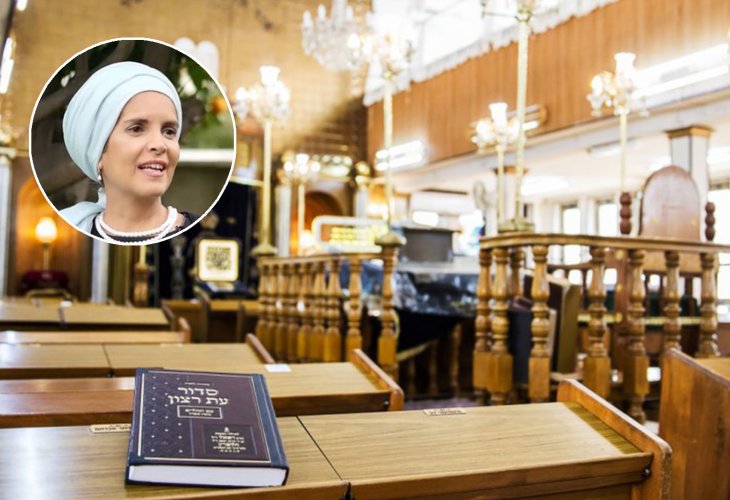Rediscovering Faith: A Unique Journey to Connect the Deaf Community with Judaism
Linoy Yitzhak, who grew deaf as an infant, embraced Judaism but encountered an unexpected challenge in communicating with rabbis. This inspired her mission to bring the beauty of Jewish teachings to the deaf and hard of hearing.
 Inset: Linoy Yitzhak (Background photo: Shutterstock)
Inset: Linoy Yitzhak (Background photo: Shutterstock)Every person returning to faith has a story, and Linoy Yitzhak's journey stands out in its distinctiveness. Her path wasn't without obstacles — particularly a surprising challenge she faced in her spiritual education. "Most rabbis have mustaches and beards, which prevented me from lip-reading," Linoy, who is hard of hearing and a key figure at the "Chushim ben Dan" association, explains.
Born a healthy child, Linoy lost her hearing due to meningitis at one year old. After undergoing a cochlear implant surgery, she uses a hearing aid and identifies as hard of hearing. "Despite my deafness, I was a confident child. I explained how people should communicate with me and wore my hair up so my hearing aid was visible," she recalls.
"This Was My First Painful Experience"
Though excelling in academics, Linoy faced social isolation. While she could lip-read teachers, classmates proved more challenging as it was impossible to track multiple lips at once during conversations or recess. In 7th grade, a pivotal incident occurred. On a school trip, after removing her hearing aid and glasses for the night, she struggled to see a friend's lips and realized she was being laughed at. "This broke me," Linoy reflects, the only deaf student in her school at that time. "For the first time, I questioned why I was different."
Even after the implant surgery, Linoy felt caught between worlds – neither fully part of the hearing nor the deaf communities. "While studying for my master's, I connected with the ‘Center for Deaf Studies,’ now ‘Circles of Hearing.’ Through them, I met others like myself and clarified my identity as hard of hearing. However, embracing Judaism brought new hurdles."
One particular lecture ignited her interest in Judaism, but she soon encountered difficulties understanding rabbis hidden behind facial hair. "During some lectures, I had a volunteer transcribe for me, allowing me to grasp the rabbi’s insights, but there are still others I can’t access," she shares.
"For Some, It Was Their First Time Praying in Community"
Linoy's work with the ‘Advancement for the Deaf’ association led to a project translating the Torah into sign language. As the organization evolved into ‘Chushim ben Dan,’ named after a deaf descendant of Jacob who overcame adversities, Linoy's mission of making Judaism accessible continued apace. This organization, under deaf rabbi Yehoshua Soudakoff, empowers the hearing-impaired through bar mitzvah preparations, weddings, and multilingual Torah classes in sign language.
During a wartime prayer gathering for soldiers' success, designed for the deaf community, psalms were shown on a screen while a signer relayed the words. This allowed a synchronized, vocal yet silent recitation that deeply moved participants, many experiencing communal prayer for the first time.
Why Translate Psalms into Sign Language When There's Written Text?
"The deaf can't audibly participate in public praying; the solution is sign language translations, allowing true communal experience," Linoy explains. Efforts at ‘Chushim ben Dan’ also include creating videos translating biblical tales like the Megillah and blessings, fostering understanding even among non-signers and enhancing Jewish connection.
How Are Unique Biblical Terms Like "Ruth the Moabite" Translated?
Linoy details how new signs are invented for distinct biblical names, like Mordecai and Esther, with community consensus on these innovations before they gain official use in educational content.
"Bridging Sign Language and Biblical Texts is a Big Task"
Translating biblical Hebrew into sign language is complex due to linguistic differences. But these translations allow the deaf to finally comprehend and connect with Jewish texts on a deeper level. Initial responses have been overwhelmingly positive, unveiling emotional insights into ancient scriptures for the very first time.
Linoy's broader ambitions include empowering bar mitzvah candidates to read Torah with sign language guidance. "One boy was ecstatic to comprehend each passage for the first time via our videos," illustrating the project's profound impact.
"Our Initiative Benefits All Students"
While primarily aiding the deaf community, these educational videos serve as valuable resources for all learners, enriching their study experience with tailored animations and thorough research. With its visually stimulating content, the project extends beyond its initial scope, inviting broader audiences to explore Jewish texts’ visual stories, like Moshe's basket or King Ahasuerus's palace. Crafted by professionals from the deaf community, this translation endeavor aims to bring Jewish teachings to all who seek them.
Linoy dreams of further initiatives like a digital prayer book for everyday use and a synagogue with regular sign language interpretation. Her journey has led her to see her experiences as gifts to bridge gaps and unite diverse segments of the Jewish world. Reflecting on her mission, Linoy concludes, "Just as others bring secular Jews closer to faith, ‘Chushim ben Dan’ extends its hand to the deaf and hard of hearing, embedding them into the fold of Jewish life."

